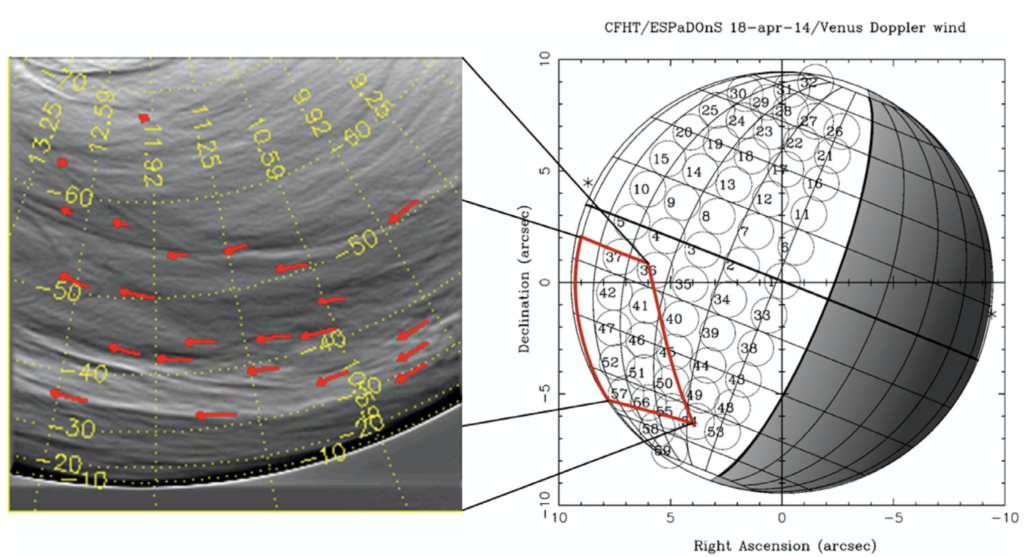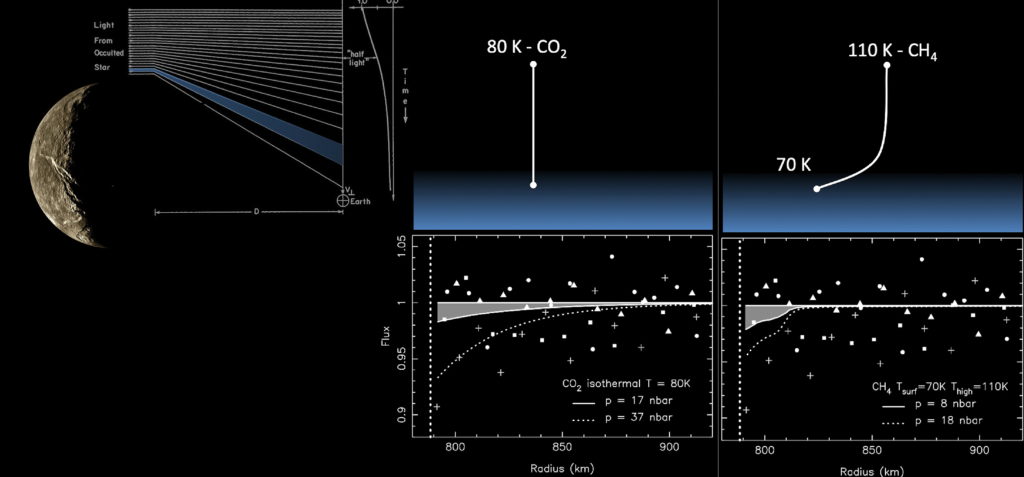My research activity focusses on ground-based and space-borne exploration of planet Venus, the second largest telluric planet of the Solar System, and ground-based measurements of other solar system objects. It encompasses analysis of wind measurements and trace gases chemistry of sulfur gases in the Venus atmosphere; it also included participation in international campaigns to observe stellar occultations from distant solar system objects such as Centaurs or Trans-Neptunian Objects.
Understanding the coupling of Venus’ atmosphere dynamics, chemistry and surface interactions
The spectrum of planet Venus when observed from space (or from Earth) can be split in three components: reflected solar radiation, infrared thermal emission from the cloud tops, and emission from the hot deep atmosphere and the surface leaking to space through the narrow spectral transparency ”windows”. The first component dominates in the UV through the near-infrared range (0.2-4. μm) over the sunlit hemisphere, while the second one prevails at longer infrared wavelengths (4-50 μm). A major fraction of the incoming solar flux is scattered back to space by thick clouds mainly composed of sulfuric acid. The albedo curve shows a broad depression in the UV-blue range. At wavelengths below 0.32 μm this absorption is explained by the presence of SO2 gas within and above the cloud tops. The absorption at longer wavelengths (0.32 μm-0.5 μm) is attributed to the presence of an unknown absorber in the upper cloud (58-65 km). In the near infrared (1-2 μm) sharp spectral features associated with absorption by CO2 and H2O within and above the cloud tops are clearly seen.
At thermal wavelengths (5 – 50 μm), the spectrum of the planet is close to that of a blackbody at the cloud top temperatures with spectral features mainly belonging to mesospheric CO2, H2O, SO2, and other gases that absorb at levels within and above the clouds as well as broad signatures of sulfuric acid aerosols. The fundamental absorption bands of CO2 at 4.3 μm, 4.8 μm, and 15 μm produce the strongest spectral features. These bands have been used to retrieve the temperature and aerosol altitude profiles in the mesosphere. Thermal infrared spectra also show a wealth of weaker absorption features belonging to hot and isotopic bands of CO2 as well as SO2, H2O, and CO above the clouds and within the upper cloud. The thermal structure of the Venus mesosphere varies strongly with latitude, with polar regions surprisingly being up to 20 K warmer than equatorial latitudes at most pressure levels between the cloud tops and 100 km. The thermal structure varies to a lesser extent with local time.
Venus atmospheric chemistry
The atmospheric chemistry of Venus is driven by the cycles of water and sulfur dioxide. Below the clouds, both species are present with relatively large abundances (about 30 ppmv and 130 ppmv respectively) and,at low latitude, are transported upward by Hadley convec- tion. Following the SO2 photodissociation and the combination of SO3 with H2O, sulfuric acid H2SO4 is formed and condenses as the main component of the cloud deck. Above the cloud top, the volume mixing ratios of H2O and SO2 drop drastically to about 1-3 ppmv. The water and sulfur dioxide cycles have been ex- tensively monitored over several decades, using Pioneer Venus, the Venera 15 spacecraft, Venus Express and Akatsuki by imaging and spectroscopy in the ultraviolet and infrared ranges. As a complement to these datasets, we have been using imaging spectroscopy in the thermal infrared since 2012 to map SO2 and H2O at the cloud top of Venus and to monitor the behavior of these two species as a function of time, both on the short term (a few hours) and the long term (years).
Venus atmospheric dynamics
The mechanisms controlling the global circulation remain largely unknown. The circulation up to the cloud tops is characterised by an increasing zonal wind, starting from an altitude of 10 km. The zonal superrotation of the cloud tops, which circle the planet in only 4.4 days, contrasts with the long rotation period of the solid globe (243 terrestrial days). At this altitude the latitudinal profile of the zonal wind is variable and is coupled with the solar tide. It is uniform at low latitudes, dropping poleward from mid-latitudes, where an intense meridional wind shear develops. On the retrograde zonal superrotating flow itself, at the basis of the mesosphere, two main, large-scale, variable components are superimposed: a solar tide and a traveling four-day wave. The solar tides are global-scale motions forced by solar heating. They are stationary with respect to the sub-solar point and thus move upstream relative to the fluid. The four-day wave consists of a Y-shaped feature seen in UV images which has been identified as a Kelvin wave. The forcing and dissipation mechanisms of the four-day wave and the solar tide are major phenomena that certainly play a role in the global dynamics but are as yet poorly understood.

Right: aspect of Venus disk as seen from Earth during the Apr. 16–19, 2014 CFHT/ESPaDOnS observing run with superimposed Venus-Express VIRTIS instrument’s FOV on Apr. 21, 2014. The figure illustrates our observing strategy to match CFHT/ESPaDOnS operations (thin black circles) and ESA/Venus Express VIRTIS-M instrument FOV (red distorted rectangle) during orbit 2923. Left: zoom-out of an image (VV2923_08) obtained with VIRTIS-M at 21 Apr. 2014 (orbit 2923), the latitudes covered the range from 10°S to 50°S and the local time spans from 10 h till 13 h. On the zoomed image (VV2923_08) we can see tracers (red arrows) marked on cloud features that will correspond to matching cloud features on this image’s pair (VV2923_11) obtained 48 minutes later (Machado et al., 2017).
Surface interactions
The main constituent of the clouds, H2SO4, in both vapour and liquid form, can be monitored near the cloud base altitude, yielding clues as to cloud formation and convection processes. Geological activity can affect clouds in several ways: (1) volcanic ash can contribute to cloud and haze layers; (2) volcanic sulphur dioxide emissions can contribute to formation of sulphate cloud & haze layers and to the as-yet unidentified UV absorber seen at cloud-tops; (3) volcanically emitted volatiles can form condensate layers; (4) heat from volcanic activity can cause changes in atmospheric circulation: (5) near- surface winds in Venus’ dense atmosphere can lift dust & other particulates from the surface into airborne suspension. Understanding the dependence of the cloud layer on outgassed mantle volatiles is critical for understanding the long-term climate evolution of the planet. All of these effects can be studied by monitoring the spatial and temporal variations of clouds and hazes. Characteristic timescales of cloud formation and dissipation have been measured to be of the order of hours to days, therefore observations on such timescales are required.
Exploring the distant solar system using light from distant stars
The distant solar system contains largely unaltered material from the primordial circumsolar disk. It also kept the memory of the planetary migrations at the early stages of solar system formationand thus contains essential information on the origin and collisional evolution of our planetary system, the nature and alteration processes of primitive bodies, and the conditions for emergence and sustainability of nitrogen atmospheres such as Pluto’s.The method of observing stellar occultations, when an astronomical body passes in front of a star casting a shadow in starlight on the Earth, provides higher spatial resolution than any other Earth-based observing method. In addition, because the light being observed passes through any atmosphere or obstacle surrounding the occulting body, the method allows direct probing of the celestial body’s environment. This unique investigation requires a combined effort in predictions, astrometrical observations and analysis, portable instrumentation, time-critical ground-based deployment, observation and analysis.
Titania is the largest uranian moon (d = 1576.8 ± 1.2 km). Near-IR spectroscopy has indicated the presence of water ice and carbon dioxide ice on the surface of Titania. While H2O ice is clearly not a candidate volatile, CO2 ice stability against sublimation over a seasonal cycle of Titania can be considered. Our analysis allowed to set surface pressure upper limits of 10-20 nbar for a CO2, CH4or N2 atmosphere (Widemann et al., Icarus 199, Vol. 2, pp. 458-476, 2009).







